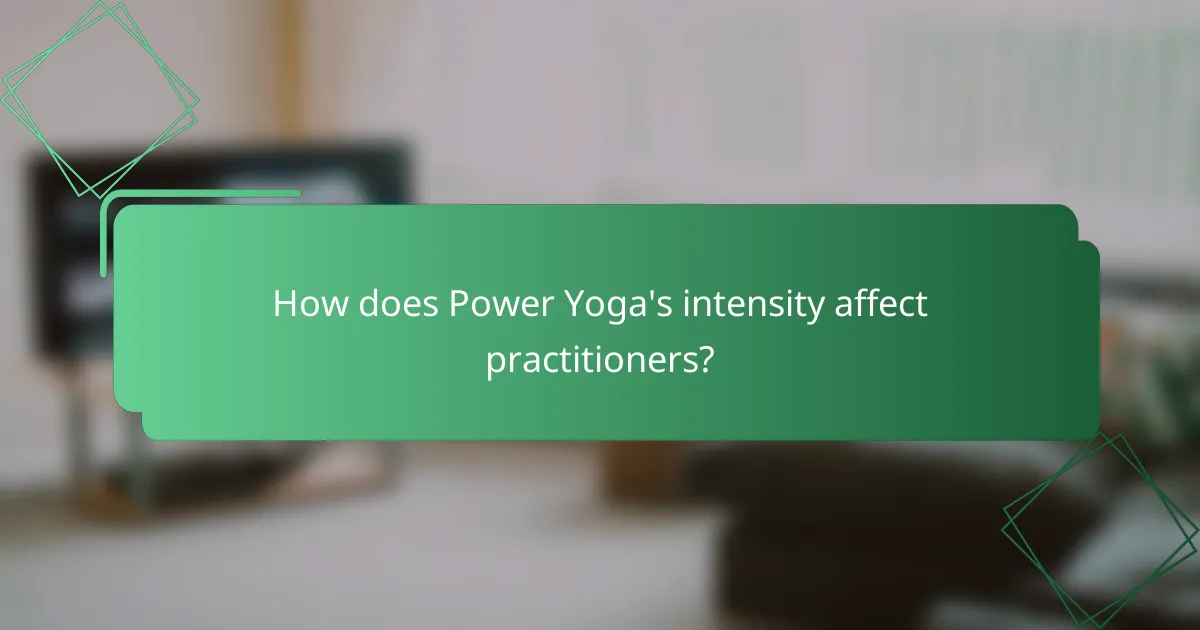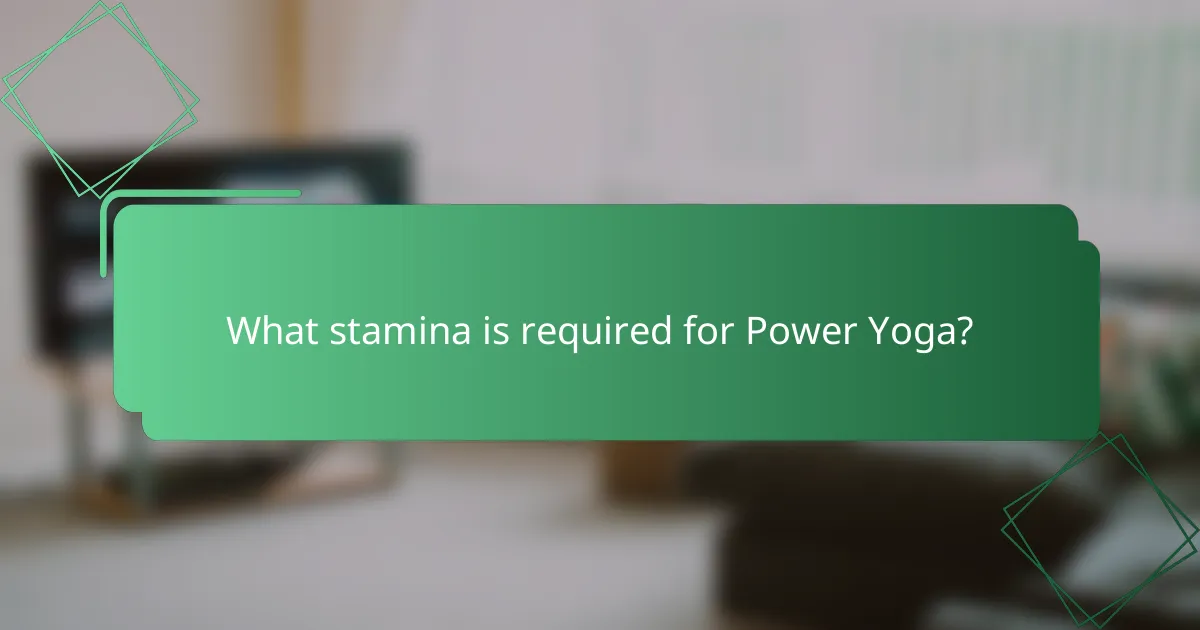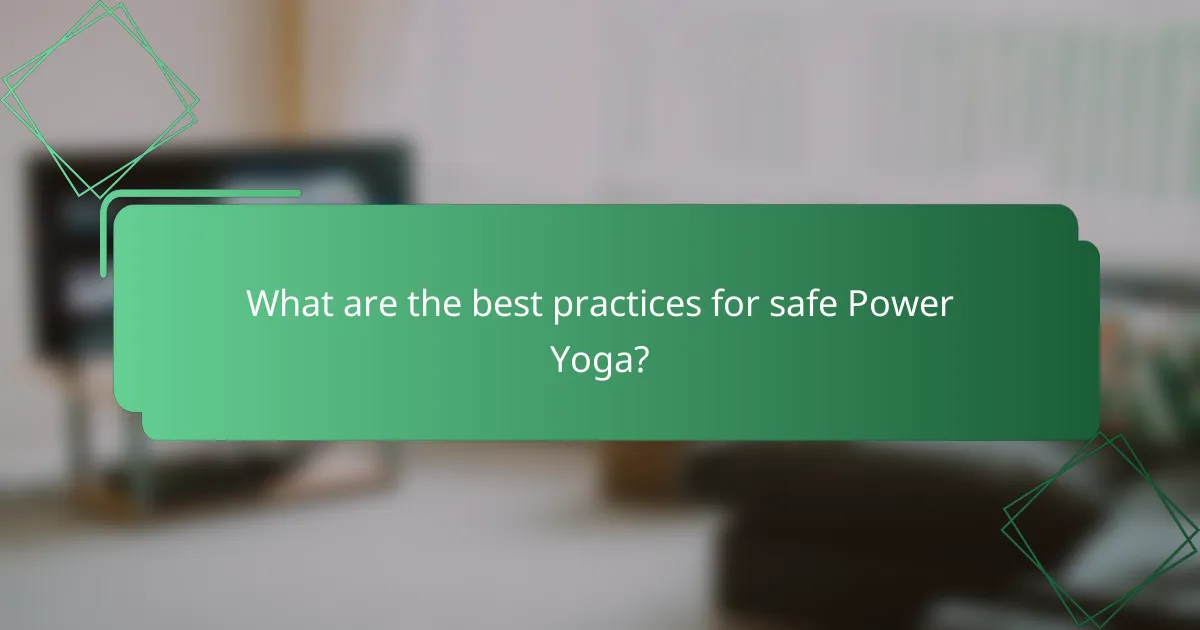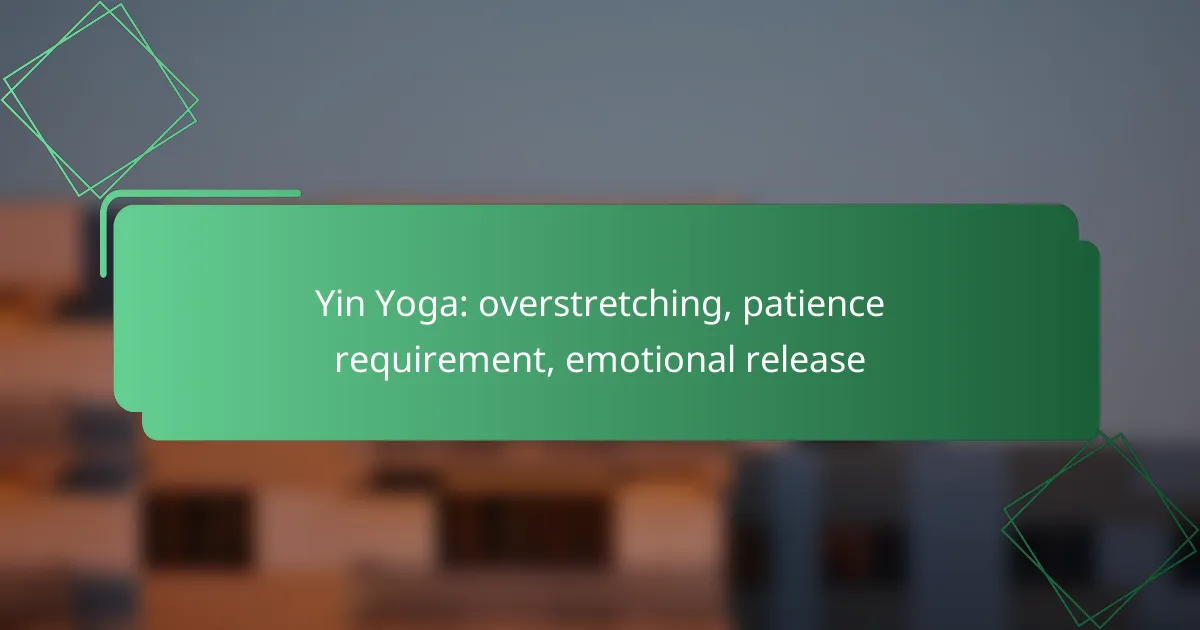Power Yoga is a vigorous form of yoga that emphasizes high-intensity movements and dynamic postures, which can enhance strength and flexibility. However, this intensity also raises the potential for injuries, particularly if practitioners neglect proper alignment and warm-up routines. As a physically demanding practice, Power Yoga requires a significant level of stamina, making it essential for participants to approach their workouts with caution and awareness.

What are the injury risks associated with Power Yoga?
Power Yoga can lead to various injury risks primarily due to its high intensity and dynamic movements. Common injuries often stem from improper alignment, overexertion, or insufficient warm-up, making awareness and prevention crucial for practitioners.
Common injuries in Power Yoga
In Power Yoga, practitioners may experience injuries such as strains, sprains, and joint issues. Common areas affected include the lower back, shoulders, and wrists, often due to the demanding poses and transitions. Overuse injuries can also occur, particularly in those who practice frequently without adequate rest.
Other potential injuries include tendonitis and muscle tears, especially in individuals who push their limits without proper conditioning. It’s essential to listen to your body and recognize signs of discomfort to prevent these injuries from becoming serious.
Preventative measures for injuries
To minimize injury risks in Power Yoga, it’s vital to focus on proper technique and alignment during poses. Practitioners should consider working with a qualified instructor who can provide guidance on form and modifications tailored to individual needs.
Incorporating a thorough warm-up and cool-down routine can also help prepare the body for intense movements and promote recovery. Additionally, maintaining a balanced practice that includes rest days and cross-training can enhance overall strength and flexibility, reducing the likelihood of injuries.

How does Power Yoga’s intensity affect practitioners?
The intensity of Power Yoga significantly influences practitioners’ physical and mental endurance, as well as their overall experience. High-intensity sessions can enhance strength and flexibility but may also increase the risk of injury if not approached with caution.
High-intensity benefits of Power Yoga
Power Yoga’s high intensity offers numerous benefits, including improved cardiovascular fitness, increased muscle strength, and enhanced flexibility. Practitioners often experience a boost in stamina, allowing them to perform daily activities with greater ease.
Additionally, the vigorous nature of Power Yoga can lead to better mental focus and stress relief. The combination of physical exertion and mindful breathing helps practitioners cultivate a sense of calm and clarity.
Risks of high-intensity Power Yoga
Despite its advantages, high-intensity Power Yoga carries certain risks, particularly for those who are new to the practice or have pre-existing injuries. Common issues include strains, sprains, and overuse injuries due to the demanding nature of the poses.
To minimize these risks, practitioners should listen to their bodies and modify poses as needed. It’s advisable to start with lower intensity sessions and gradually increase the difficulty as strength and flexibility improve. Regularly consulting with a qualified instructor can also help ensure safe practice.

What stamina is required for Power Yoga?
Power Yoga demands a moderate to high level of stamina, as it involves continuous movement and dynamic postures. Practitioners should be prepared for a physically challenging workout that can elevate heart rates and build endurance over time.
Stamina levels for beginners
Beginners in Power Yoga typically need to develop basic stamina to handle the flow of movements. Starting with shorter sessions, around 30 minutes, can help build endurance gradually. It’s advisable to focus on foundational poses and breathing techniques to enhance stamina without overwhelming the body.
New practitioners should listen to their bodies and take breaks as needed. Incorporating other forms of exercise, such as walking or light cardio, can also help improve overall stamina, making Power Yoga more accessible.
Advanced stamina requirements
Advanced Power Yoga practitioners require significant stamina to maintain the intensity and duration of their sessions, often lasting 60 minutes or more. This level of practice involves complex sequences that demand both physical strength and cardiovascular endurance.
To meet these advanced stamina requirements, individuals should engage in regular training that includes both Power Yoga and complementary exercises, such as strength training or high-intensity interval training (HIIT). Staying hydrated and maintaining proper nutrition is crucial for sustaining energy levels during longer sessions.

How can one choose the right Power Yoga class?
Choosing the right Power Yoga class involves assessing your fitness level, goals, and the class environment. Look for classes that match your intensity preference and provide a supportive atmosphere for your practice.
Factors to consider when selecting a class
When selecting a Power Yoga class, consider your current fitness level and any previous injuries. Classes can vary in intensity, so it’s essential to find one that challenges you without risking injury. Look for instructors who emphasize safety and proper alignment.
Additionally, consider the class size and atmosphere. Smaller classes may offer more personalized attention, while larger classes can provide a community feel. Check if the studio’s schedule aligns with your availability to ensure consistency in your practice.
Recommended Power Yoga studios in New York
New York City offers a variety of Power Yoga studios catering to different needs. Some popular options include:
- YogaWorks: Known for its experienced instructors and diverse class offerings.
- CorePower Yoga: Offers a high-energy environment with a focus on strength and stamina.
- Jivamukti Yoga: Combines physical practice with spiritual teachings, ideal for those seeking a holistic approach.
Before enrolling, consider visiting for a trial class to gauge the instructor’s style and the studio’s atmosphere. This can help ensure you find the right fit for your Power Yoga journey.

What are the best practices for safe Power Yoga?
To practice Power Yoga safely, it’s essential to incorporate proper warm-up and cool-down routines, maintain awareness of your body’s limits, and focus on alignment during poses. These practices help minimize injury risk while enhancing performance and stamina.
Warm-up routines
Effective warm-up routines prepare your body for the intensity of Power Yoga by gradually increasing heart rate and flexibility. Start with gentle stretches targeting major muscle groups, such as the hamstrings, quadriceps, and shoulders, for about 5-10 minutes.
Incorporate dynamic movements like arm circles, leg swings, and torso twists to engage your core and improve mobility. This approach not only reduces the risk of injury but also enhances your overall performance during the session.
Cool-down techniques
Cool-down techniques are crucial for recovery after a Power Yoga session, helping to lower heart rate and prevent muscle stiffness. Spend 5-10 minutes performing static stretches, focusing on areas that were heavily engaged, such as the back, hips, and legs.
Incorporate deep breathing exercises to promote relaxation and mindfulness, allowing your body to transition back to a resting state. This practice aids in muscle recovery and prepares you for your next session, ensuring a sustainable Power Yoga routine.

What are the emerging trends in Power Yoga?
Emerging trends in Power Yoga focus on enhancing the practice through technology and accessibility. As practitioners seek more engaging and flexible options, innovations like online classes and fitness apps are becoming increasingly popular.
Integration of technology in Power Yoga
The integration of technology in Power Yoga includes the use of fitness apps, virtual reality, and wearable devices. These tools can track performance metrics such as heart rate and calories burned, helping practitioners monitor their progress and adjust their routines accordingly.
For example, apps that offer guided sessions can provide real-time feedback on posture and alignment, which is crucial for preventing injuries and maximizing benefits. Additionally, virtual reality experiences can create immersive environments that enhance motivation and enjoyment during practice.
Popularity of online Power Yoga classes
Online Power Yoga classes have surged in popularity, particularly due to their convenience and accessibility. Practitioners can join classes from the comfort of their homes, often at a lower cost than traditional studio sessions.
Many platforms offer a variety of class styles and durations, catering to different skill levels and schedules. This flexibility allows individuals to maintain a consistent practice, which is essential for building stamina and strength over time. However, it’s important to choose reputable instructors to ensure quality guidance and minimize injury risk.










